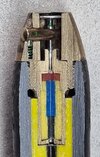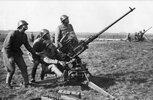pzgr40
Well-Known Member
Cutaway model of a 'Bg patroon v 2 tL tracer No.1', fuzed with the impact nose fuze No.62.
The 2cm Oerlikon 20x110 was a further development of the German Becker automatic gun from the First World War. Between the First and Second World War, various light anti-aircraft machine guns were tested in the Netherlands, and the 2cm Oerlikon came out as best, although there were some doubts about the stability of the tripod gun mount. In December 1938, the state-owned AI company was ordered to sign a contract with Oerlikon for the supply of 100 pcs of the 2cm anti-aircraft guns type JLaS to strengthen the air defense against low-flying enemy aircraft.
In 1939 the AI (Hembrug) ordered 175 pcs 20 mm Oerlikon guns type JLaS; (in the Netherlands it was given the name 'Kanon 2 tL No. 1.'), as well as 15,000 practice cartridges (platzpatronen), 500,000 high-explosive grenades with tracer (UL) and 450,000 tracer high-explosive grenades with doppelzunder (HZ). A second order for 125 guns followed in 1939, but due to an export restriction from Switzerland due to the Swiss mobilization, only 100 were delivered. Ultimately, in May 1940, one hundred and seventy 2 tL No.1 guns were available, which were used by various units of the Dutch army.
The effective range of the 2cm Oerlikon was 1800 meters. The effect of the high-explosive grenade on the target was not very great, but with several hits an enemy aircraft was definitely disabled.
Functioning of the projectile and the impact nose fuze Nr. 62 (photo 03);
When the shot is fired, the axial pin (1) moves backwards through inertia, riding the spring (2), releasing the radial fork (3) that fixates the firing pin (4) in it's forward position. The fork (3) moves outward by the centrifugal force. However, in the barrel passage, the wall of the barrel stops the fork (3) from moving out completely, it cannot move out further than 1 a 2 mm and fixates the firing pin (4) in the forward position during the barrel passage. After leaving the barrel, the fork (3) falls out of the fuze body, releasing the firing pin (4) and leaving it in a floating state. When hitting the target, the firing pin is driven inward into the firing cap (red) of the detonator, which detonates and ignites the projectile.
When the grenade is fired, the tracer is also ignited and burns up. If the target is not hit by the impact nose fuze, it ignites the black powder charge at the end of the tracer, which ignites the pyrotechnic fuse running through the explosive charge. This burns up and ignites the pyrotechnic fuse in the base of the detonator. When it reaches the heat-sensitive explosive (blue) in the detonator, the detonator is ignited and the projectile self-destructs.
The explosive charge of the grenade consists of Pentryl, a mixture of Pentrite and Tetryl.
Length complete cartridge : 179,2 mm
Projectile length : 78,8 mm
Weight complete cartridge : 243,5 grams
Weight projectile with fuze : 126,5 grams
Weight shellcase : 87,5 grams
Weight powder charge : 29,5 grams
Firing rate : 180 rnds/minute
Magazine : stick magazine with 15 catridges
Regards, DJH
The 2cm Oerlikon 20x110 was a further development of the German Becker automatic gun from the First World War. Between the First and Second World War, various light anti-aircraft machine guns were tested in the Netherlands, and the 2cm Oerlikon came out as best, although there were some doubts about the stability of the tripod gun mount. In December 1938, the state-owned AI company was ordered to sign a contract with Oerlikon for the supply of 100 pcs of the 2cm anti-aircraft guns type JLaS to strengthen the air defense against low-flying enemy aircraft.
In 1939 the AI (Hembrug) ordered 175 pcs 20 mm Oerlikon guns type JLaS; (in the Netherlands it was given the name 'Kanon 2 tL No. 1.'), as well as 15,000 practice cartridges (platzpatronen), 500,000 high-explosive grenades with tracer (UL) and 450,000 tracer high-explosive grenades with doppelzunder (HZ). A second order for 125 guns followed in 1939, but due to an export restriction from Switzerland due to the Swiss mobilization, only 100 were delivered. Ultimately, in May 1940, one hundred and seventy 2 tL No.1 guns were available, which were used by various units of the Dutch army.
The effective range of the 2cm Oerlikon was 1800 meters. The effect of the high-explosive grenade on the target was not very great, but with several hits an enemy aircraft was definitely disabled.
Functioning of the projectile and the impact nose fuze Nr. 62 (photo 03);
When the shot is fired, the axial pin (1) moves backwards through inertia, riding the spring (2), releasing the radial fork (3) that fixates the firing pin (4) in it's forward position. The fork (3) moves outward by the centrifugal force. However, in the barrel passage, the wall of the barrel stops the fork (3) from moving out completely, it cannot move out further than 1 a 2 mm and fixates the firing pin (4) in the forward position during the barrel passage. After leaving the barrel, the fork (3) falls out of the fuze body, releasing the firing pin (4) and leaving it in a floating state. When hitting the target, the firing pin is driven inward into the firing cap (red) of the detonator, which detonates and ignites the projectile.
When the grenade is fired, the tracer is also ignited and burns up. If the target is not hit by the impact nose fuze, it ignites the black powder charge at the end of the tracer, which ignites the pyrotechnic fuse running through the explosive charge. This burns up and ignites the pyrotechnic fuse in the base of the detonator. When it reaches the heat-sensitive explosive (blue) in the detonator, the detonator is ignited and the projectile self-destructs.
The explosive charge of the grenade consists of Pentryl, a mixture of Pentrite and Tetryl.
Length complete cartridge : 179,2 mm
Projectile length : 78,8 mm
Weight complete cartridge : 243,5 grams
Weight projectile with fuze : 126,5 grams
Weight shellcase : 87,5 grams
Weight powder charge : 29,5 grams
Firing rate : 180 rnds/minute
Magazine : stick magazine with 15 catridges
Regards, DJH
Attachments
Last edited:



